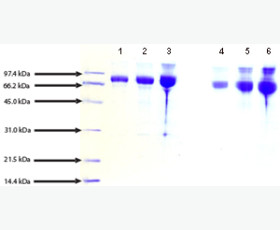Recombinant Human Hematopoietic Prostaglandin D Synthase/HPGDS/GSTS
| Product name: | Recombinant Human Hematopoietic Prostaglandin D Synthase/HPGDS/GSTS |
| Source: | E. coli |
| Purity: | Greater than 95% as determined by reducing SDS-PAGE. |
| Buffer Formulation: | Supplied as a 0.2 μm filtered solution of 20mM Tris, 200mM NaCl, pH 7.0. |
| Applications: | Applications:SDS-PAGE; WB; ELISA; IP. |
| Storage: | Avoid repeated freeze/thaw cycles. Store at 2-8 oC for one month. Aliquot and store at -80 oC for 12 months. |
| UOM: | 100ug/50ug/200ug/1mg/1g |
| Source | E. coli |
| Description | Recombinant Human Hematopoietic Prostaglandin D Synthase is produced by our E.coli expression system and the target gene encoding Met1-Leu199 is expressed. |
| Names | Hematopoietic Prostaglandin D Synthase, H-PGDS, GST Class-Sigma, Glutathione S-Transferase, Glutathione-Dependent PGD Synthase, Glutathione-Requiring Prostaglandin D Synthase, Prostaglandin-H2 D-Isomerase, HPGDS, GSTS, PGDS, PTGDS2 |
| Accession # | O60760 |
| Formulation | Supplied as a 0.2 μm filtered solution of 20mM Tris, 200mM NaCl, pH 7.0. |
| Shipping |
The product is shipped on dry ice/ice packs. |
| Storage |
Store at < -20°C, stable for 6 months after receipt. Please minimize freeze-thaw cycles. |
| Purity |
Greater than 95% as determined by reducing SDS-PAGE. |
| Endotoxin | Less than 0.1 ng/µg (1 IEU/µg) as determined by LAL test. |
| Amino Acid Sequence |
MPNYKLTYFNMRGRAEIIRYIFAYLDIQYEDHRIEQADWPEIKSTLPFGKIPILEVDGLTLHQSL AIARYLTKNTDLAGNTEMEQCHVDAIVDTLDDFMSCFPWAEKKQDVKEQMFNELLTYNAPHLMQD LDTYLGGREWLIGNSVTWADFYWEICSTTLLVFKPDLLDNHPRLVTLRKKVQAIPAVANWIKRRP QTKL
|
| Background | Hematopoietic Prostaglandin D Synthase (HPGDS) belongs to the GST superfamily and Sigma family. HPGDS contains one GST C-terminal domain and one GST N-terminal domain. HPGDS is highly expressed in adipose tissue, macrophages, and placenta, and it exists in the form of homodimer in living body. HPGDS is a cytosolic enzyme that isomerizes PGH(2). HPGDS is a bifunctional enzyme that catalyzes both the conversion of PGH2 to PGD2 and also shows low glutathione-peroxidase activity towards cumenehydroperoxide. |














